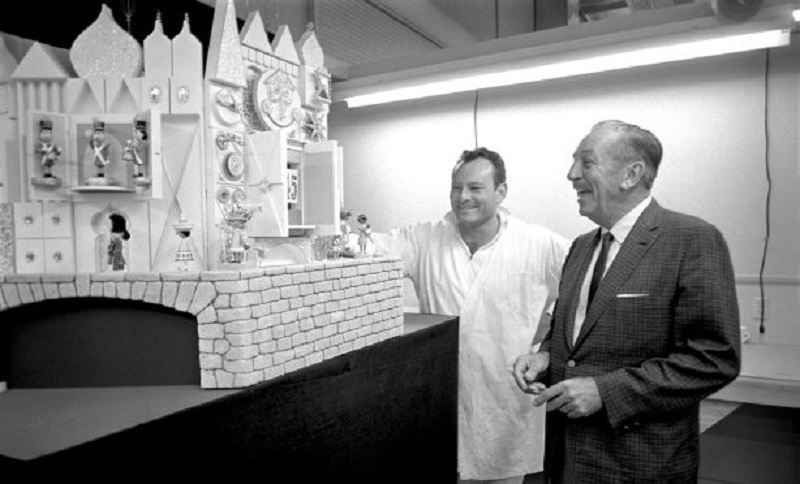
Disney legend Rolly Crump, an Imagineer who was instrumental in the design of early Disneyland and Walt Disney World attractions, passed away on 12 March in his Carlsbad, California home. He was 93. Described as a ‘true original,’ Crump brought his artistic talent to a multitude of Disney projects, most famously during his time at Walt Disney Imagineering.
He served as a key designer for Disney’s attractions at the 1964-1965 New York World’s Fair, as well as beloved classics like Haunted Mansion and Walt Disney’s Enchanted Tiki Room.
“Rolly was always able to see a different way of doing things. I think that fascinated Walt Disney, who was always looking for innovations,” said Tony Baxter, who worked alongside Crump on EPCOT and other Imagineering projects for Walt Disney World Resort. “When Rolly was right with his innovative approaches, they often turned out to be among the most memorable aspects of Disney Parks. Another thing that distinguished Rolly was his total enjoyment of creative work and being around other creative people at Imagineering.”
“Rolly was a quintessential element of my, and many others’ mentorship at Imagineering. Of all the original art directors of the 1970s, Crump was the fun guy,” said Walt Disney Imagineering executive creative director Kim Irvine.
Born Roland Fargo Crump on 27 February 1930 in Alhambra, California, Crump always had his eye on The Walt Disney Company. First, Crump took a pay cut as a ‘dipper’ in a ceramic factory to join The Walt Disney Studios in 1952—then, he started building sewer manholes on weekends so he could pay his bills and continue working at Disney. His early work at Disney Animation included serving as an in-between artist and (later) assistant animator, contributing to Peter Pan (1953), Lady and the Tramp (1955), Sleeping Beauty (1959) and others.
In 1959, he joined show design at WED Enterprises (now known as Walt Disney Imagineering, or WDI) and became a key designer for some of Disneyland’s most iconic attractions and shops, including the Haunted Mansion, Walt Disney’s Enchanted Tiki Room, and Adventureland Bazaar. While helping design ‘it’s a small world,’ he created the famed Tower of the Four Winds marquee. He continued to design striking entrances for ‘it’s a small world’ when the attraction moved to Disneyland in 1966; the larger-than-life animated clock at its entrance, which sends puppet children on parade with each quarter-hour gong, is straight from Crump’s imagination.
His peers at Imagineering considered him an accomplished collaborator—a skill that his son, Chris Crump, took note of as he followed in his father’s footsteps to join WDI. “What I observed was that Rolly had really great relationships with the people that he worked with. It is important to know the skills of your co-workers, and to trust and respect them. I watched Rolly interact with his peers and was impressed with how well-respected he was,” explained Chris.
As the world of Disney Parks expanded, so did Crump’s creations. Besides working on the initial designs for the Magic Kingdom at Walt Disney World Resort in Florida, he contributed to EPCOT Center (later known as EPCOT) after a brief period away from the company. Crump served as project designer for The Land pavilion and developed concepts for the Wonders of Life pavilion, later redesigning and refurbishing The Land and Innoventions.
“In the 1980s, as WED was seriously concentrating on other projects around the world, [Imagineering leaders] Marty Sklar and John Hench asked Rolly to develop a team that would stay focused on Disneyland,” Irvine recalled. “Three colleagues and I would drive down to Disneyland at least two times a week and walk the park with Rolly. It was such a wonderful experience, as he knew the backstories of so many elements of Disneyland. Today, our team is 45 cast members strong and still providing the new designs and direction for the Disneyland Resort.”
Crump participated in master planning for an expansion of Disneyland until 1981, when he again left Disney to design for other companies—and to launch his own firm, the Mariposa Design Group, developing an array of themed projects around the world, including an international celebration for the country of Oman.
Crump ‘retired’ from The Walt Disney Company in 1996, but continued to work on a number of creative projects. He published an autobiography, It’s Kind of a Cute Story, in 2012.
Crump, who was inducted as a Disney Legend in 2004, is survived by his wife, Marie Tocci; his children Christopher, Roxana, Theresa; and three grandchildren.

